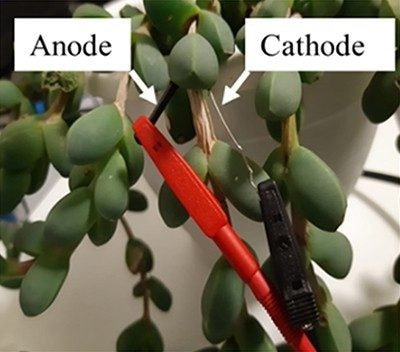Plants can provide food, oxygen, and decor, but they are not commonly thought to be useful sources of electricity. Researchers can produce electricity as part of a “green,” biological solar cell by capturing electrons naturally carried within plant cells. Scientists have now employed a succulent plant to build a living “bio-solar cell” that works on photosynthesis for the first time, as reported in ACS Applied Materials & Interfaces.
 The ice plant succulent shown here can become a living solar cell and power a circuit using photosynthesis. Image Credit: Adapted from ACS Applied Materials & Interfaces.
The ice plant succulent shown here can become a living solar cell and power a circuit using photosynthesis. Image Credit: Adapted from ACS Applied Materials & Interfaces.
Electrons are shuttled around in all living cells, from bacteria and fungi to plants and animals, as part of natural, biochemical processes. However, if electrodes are present, the cells can produce electricity that can be used outside.
Previously, researchers used bacteria to construct fuel cells in this manner, but the microorganisms had to be fed on a regular basis. To create current, experts, including Noam Adir’s team, have turned to photosynthesis. Light causes a flow of electrons from water during this process, which culminates in the production of oxygen and sugar.
This means that, like a solar cell, living photosynthetic cells are constantly creating a flow of electrons that can be extracted as a “photocurrent” and utilized to power an external circuit.
Certain plants, such as succulents prevalent in arid areas, have thick cuticles that allow water and nutrients to remain within the leaves. Yaniv Shlosberg, Gadi Schuster, and Adir wanted to see if photosynthesis in succulents could generate electricity for living solar cells by employing their internal water and nutrients as the electrolyte solution of an electrochemical cell for the first time.
The succulent Corpuscularia lehmannii, popularly known as the “ice plant,” was used by researchers to produce a living solar cell. They measured the voltage of one of the plant’s leaves after inserting an iron anode and a platinum cathode. When linked to a circuit, it produced up to 20 µA/cm2 of photocurrent density when exposed to light and could create current for more than a day.
Though these figures are lower than those of a standard alkaline battery, they only reflect a single leaf. Previous research on comparable organic devices indicates that putting numerous leaves in series may enhance the voltage.
The living solar cell was specifically built such that protons in the internal leaf solution may combine to generate hydrogen gas at the cathode, which could then be collected and used in other applications.
According to the researchers, their method could pave the way for the creation of future sustainable, multifunctional green energy solutions.
Source:
Journal reference:
Shlosberg, Y., et al. (2022) Self-Enclosed Bio-Photoelectrochemical Cell in Succulent Plants. ACS Applied Materials & Interfaces. doi.org/10.1021/acsami.2c15123.